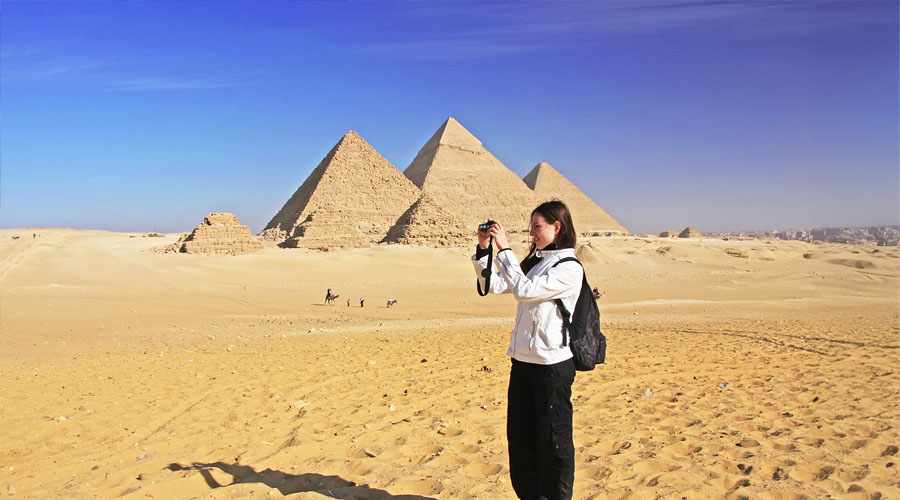

Should I Go to Egypt Only for the Pyramids?
2025-07-17
This is a question we get asked a lot. Since the Great Pyramids are located in Cairo - well, Giza, if we're being technically correct - do I really need to stay for more than a few days in Egypt? Many travelers wonder if they can just pop in, see the pyramids, and spend more valuable vacation time at their next destination. After all, there are so many convenient international flights in and out of Cairo.
While enjoying Egypt as a quick stopover is certainly possible, we always say the same thing: going to Egypt and not leaving Cairo would be a huge missed opportunity. The Great Pyramids are spectacular, yes, but they're just the tip of the iceberg.
Why You Should Venture Beyond Cairo?
Ancient Egypt's most awe-inspiring historical treasures are along the Nile River, especially around the southern cities of Luxor and Aswan. These cities hold the true heart of Egyptian history and contain many of the ancient world's most iconic monuments.
Understandably, many travelers hesitate to board another flight after a long international journey. But the flight from Cairo to Luxor is only about an hour, and what it unlocks is nothing short of incredible.
Must-See Highlights Beyond Cairo:
Karnak and Luxor Temples
These two monumental temple complexes - connected by a road lined with hundreds of human-headed sphinx statues - sit on the east bank of the Nile in Luxor and are among Egypt's largest and most impressive ancient temples, a sprawling complex of sanctuaries, obelisks, and massive columns. The atmospheric sites come alive when lit up at night, especially during the Sound and Light Show (usually an optional add-on), which adds dramatic narration and music among laser visuals.
The Valley of the Kings
On Luxor's west bank lies the Valley of the Kings, a golden canyon where pharaohs of the New Kingdom, including the famous Tutankhamun, were buried in richly decorated tombs carved into the rock. Although the tombs are empty, exploring these underground chambers with well-preserved hieroglyphs and wall artwork makes for an adventurous Indiana Jones-like experience.
Hatshepsut Temple
Also, in Luxor's West Bank, the Temple of Hatshepsut stands dramatically built into the landscape with cliffs towering above it. This elegant, terraced structure honors one of Egypt's few female pharaohs and is a marvel of ancient design and symmetry.
Colossi of Memnon
While it's usually done as a quick photo stop on the way back from visiting the former two sites in the West Bank of Luxor, the Colossi of Memnon is a worthwhile visit nonetheless. These two massive stone statues of Pharaoh Amenhotep III have endured for over 3,000 years, once part of a grand temple complex that has long since disappeared.
Edfu Temple
Halfway between Luxor and Aswan lies one of Egypt's best-preserved temples: the Temple of Horus at Edfu. Dedicated to the falcon-headed god Horus, this temple offers an almost complete look at what a Ptolemaic temple once looked so well-preserved that many hieroglyphs and reliefs still appear vividly carved into the stone.
Kom Ombo Temple
Unique in Egypt, Kom Ombo is dedicated to two gods: the falcon god Horus and the crocodile god Sobek. Its unusual design reflects this dual dedication. It's also worth checking out the nearby museum, which houses mummified crocodiles discovered in the region. It's a little odd but memorable.
Philae Island Temple
The Temple of Philae is accessible only by boat and sits on a small island near Aswan. Dedicated to the goddess Isis, this serene temple complex offers one of the most quaint and picturesque settings of any Egyptian historical site. Its unique location and mythological significance make it an essential stop.
Aswan's High Dam
A modern engineering marvel, the Aswan High Dam helped control the flow of the Nile and generate electricity for Egypt. However, it also required the relocation of several ancient temples. Visiting the dam provides insight into how modern Egypt has shaped and preserved its ancient heritage.
Abu Simbel Temples
No visit to Egypt is complete without a journey to the monumental Temples of Abu Simbel, often described as second only to the Grand Pyramids. The scale of the site is jaw-dropping, with four colossal statues guarding the entrance to the main temple and the massive interior halls. Equally remarkable is how the entire complex was moved piece by piece in the 1960s to prevent it from being submerged after the creation of Lake Nasser.
Back in Cairo…
Of course, there is still much more to see in Cairo beyond the Great Pyramids of Giza and the Sphinx. Egypt's capital is a city where ancient wonders sit alongside the energy of a modern metropolis. Here are some must-sees to make the most of your time in Cairo:
The Grand Egyptian Museum (GEM)
After over a decade of anticipation, you can now visit the largest archeological museum in the world. Located close to the Giza plateau - with the Grand Pyramids within view from inside - the GEM is a wonderfully curated journey through Egypt's past. Many artifacts are on public display for the first time after decades in storage, including a dedicated gallery for Tutankhamun's treasures and an exhibit featuring the massive Khufu solar boat.
The National Museum of Egyptian Civilization (NMEC)
The NMEC presents the full span of Egyptian history, from prehistoric times through the Pharaonic, Greco-Roman, Coptic, Islamic, and modern and contemporary eras. The highlight is the Royal Mummies Gallery, where you can see the real, preserved remains of 22 ancient rulers, the most famous of which include Ramesses II, Queen Hatshepsut, and Thutmose III. QR codes allow visitors to scan and learn about each ruler's life and legacy.
The Ancient City of Memphis
Once the capital of Egypt during the Old Kingdom, Memphis is now an open-air museum. Though little of the original city remains, the visit is worth it for the colossal statue of Ramesses II laid out horizontally, giving visitors a rare, up-close view of the incredible ancient craftsmanship.
The Step Pyramid of Djoser in Sakkara
Before the iconic pyramids of Giza were built, there was Saqqara (also spelled Sakkara), a vast desert necropolis that served as a royal burial ground during the Old Kingdom. It is home to the Step Pyramid of Djoser, the very first pyramid ever built and the earliest large-scale stone structure in the world. Visitors can also explore elaborately decorated tombs and the mysterious Serapeum, a subterranean network of granite sarcophagi built for the sacred Apis bulls.
Khan El Khalili Bazaar
For a vibrant taste of Cairo's culture, head to Khan El Khalili, one of the world's oldest continuously operating markets. Merchants have been trading here since the 14th century, and while many goods today are modern souvenirs, you'll still find traditional items like carpets, tea ware, and spices that have been sold for generations. Bargaining is not just encouraged here; it's considered a ritual of the Bazaar. Don't be shy, and be prepared to walk away if the price isn't right.
Alexandria day trip from Cairo
Founded by Alexander the Great in 331 BC, it is a historic city on Egypt's Mediterranean coast. Renowned for its rich cultural heritage, it was home to the legendary Library of Alexandria, a center of learning and scholarship in the ancient world. The city's stunning waterfront, highlighted by the iconic Lighthouse of Alexandria, one of the Seven Wonders of the Ancient World, attracts visitors with its blend of history and modernity.
Bahariya Oasis - Day trip from Cairo
It is located in Egypt's Western Desert, a lush haven filled with palm trees, hot springs, and rich historical significance. This fertile area offers stunning black-and-white desert landscapes, contrasting beautifully with its greenery. Visitors are attracted to archaeological sites like the Valley of the Golden Mummies, which showcase the oasis's fascinating history.
Hurghada beach - Tour extension
It is a vibrant resort town on the Red Sea coast of Egypt. Known for its stunning beaches, crystal-clear waters, and vibrant coral reefs, it attracts tourists worldwide and offers a range of activities, such as snorkeling, diving, and windsurfing.
St. Catherine's Monastery - Tour extension
Located at the foot of Mount Sinai in Egypt, it is one of the world's oldest continuously inhabited Christian monasteries. Founded in the 6th century, it is renowned for its stunning architecture, ancient manuscripts, and many icons. The monastery is a UNESCO World Heritage site and holds great significance for Christians and scholars, serving as a pilgrimage destination for those seeking spiritual and historical insights.
So, Can You Go to Egypt Only for the Pyramids?
You can. But why would you?
Egypt is not just a place to check off a single bucket-list monument; it's a journey through one of the most incredible civilizations in human history. To experience it fully, you'll want to travel south along the Nile and off Cairo's beaten path to discover just how much the country offers.
Reviews
This tour delivered far more than I expected, right from the minute we stepped off of the plane!
Right from the minute we stepped off the plane we were greeted by an exceptional BlueSky representative. Hotel and Cruise were excellent. Daily agendas were well planned. The staff on the cruise went above and beyond to ensure we were comfortable and our needs met.
I just wanted to tell you how fabulous our trip to India was and thanks again for your help!
We really enjoyed having our own little car with a driver and guide for the week. It was a wonderful glimpse of this part of India, our recollections of the elephants, the cows, the camels, the traffic and the forts and antiquities will remain near the top of our experiences.
All in all it was a very memorable nature & cultural experience!
We had a great time. Very scenic area. Weather was sunny & nice & wildlife sightings were great.....we even saw the white spirit bear. It was the lodge's first sighting of the year & Kathy was the first to spot it from the boat. The staff was very friendly, welcoming & accommodating.

